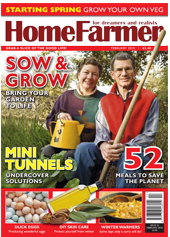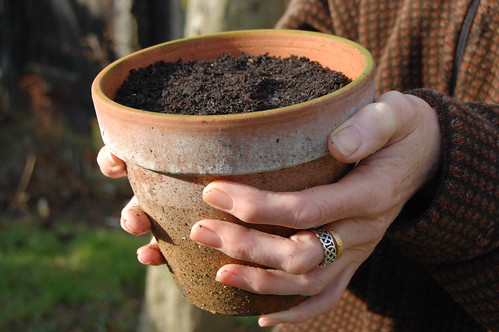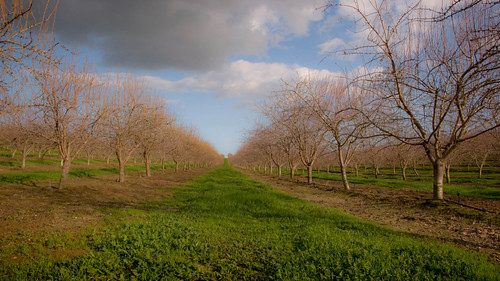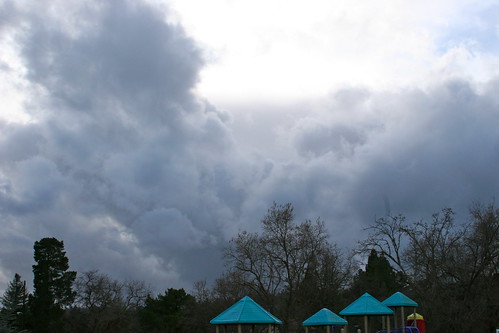Archive for February, 2010
5 Simple Steps to Making Your Own Dirt
Composting is the art of turning organic matter and waste into a rich soil amendment called humus. Backyard composting is easy to learn and is full of benefits for you and the environment. Plus, most needed ingredients are right at your finger tips. Organic matter and wastes that can be composted include fruit and vegetable peelings (kitchen scraps), grass clipping, leaves, and small diameter tree trimmings. Some things you should not include in your backyard compost include meat and dairy products, weeds or weed seeds. These materials can attract vermin and pests, and can spread weeds throughout your yard.
The Five Key Steps…
Compost Bin Size and Volume: Ideally the bin should be between 3’x3’x3’ and 5’x5’x5’. A bin that is too small cannot produce enough heat to cook the ingredients. If the bin is too large, it won’t get enough air in the center of the pile, allowing the pile to breathe. It is also easier to manage two or three medium bins than one large one.
Feed Your Compost: A perfect mix of compost materials consists of ½ brown matter (carbon-based material) like leaves and ½ green matter (nitrogen-based material) like kitchen scraps. Waste material should be mixed by weight, i.e. 5-pounds brown to 5-pounds green.
Let Your Bin Breathe: The organisms that live inside your compost pile need air to survive. Mix or turn the pile three to five times per season using a pitchfork, garden hoe or shovel. Proper aeration can make a big difference. You will know if your bin is not getting enough oxygen because it will begin to smell of ammonia.
Microbes Need H2O: The organisms also need water to survive, but not too much or they will drown. The ideal moisture level of your compost bin should be like a wrung out sponge.
Surface Area: Cutup or shred organic materials before placing them into the bin. This increases the surface area and speeds up decomposition. You can also store your kitchen scraps in the freezer to speed up decomposition, as the materials will break down at the cell level when frozen.
Compost bins can be found through most city waste management programs or can be built out of simple materials like wooden pallets or wire panels. But, no matter what method you use, the important thing is getting these nutrient rich materials back into your soil so it can be healthy and vibrant for growing fruits, vegetable and flowers.
For compost bin ideas and plans check out this University of Wisconsin Extension link
![]() photo credit: nicer than air
photo credit: nicer than air
How do you combine your homesteading life with your work life?
…How do you combine your homesteading life with your work life?
For most of us living on a suburban lot, but dreaming of a life in the country, a full-time job spent under fluorescent lights and behind ergonomic office furniture is a reality as much as it is a necessity. Our head may be in the corporate world, but our hearts are steadfastly entrenched in gardens and coops and fresh baked bread. This is the way I’ve lived most of my adult life – one foot in the corporate world and the other in the country.
Balancing the two can be a tricky proposition, full of schedules, compromises, hard work and strange looks from co-workers and neighbors alike. But – it can be done and done successfully.
At this point I think it’s fair to say that none of us are perfect, we don’t ALL live an off-grid, in a stick to ourselves kind of life. We are part of our community, with schools and organizations and activities. We are doing what we can, with the resources we have and within the parameters of city or town regulations.
I think it’s also fair to remind everyone (in case you haven’t read About Me) I have a degree in Agriculture, I’ve raised sheep since I was 11-years old, I was married to a farmer, I’m now single and I currently live on a third-acre that is zoned for all livestock except for horses. So, my capabilities for self-sufficiency are different from those who have limited space or stricter regulations.
Having said that – “How Do We Do Both”, and live as much of the homesteading life as we can? First, I think each person must take a hard look at their current lifestyle. What they currently do for fun, work, improving ones self, exercise, etc and then decide what part of the homesteading life or how much homesteading they want to do.
If you work an 80-hour week with frequent business trips you’d be hard pressed to keep a potted plant alive much less grow enough vegetables for your family’s dinner table. Even if this is not your situation, how much time you spend running kids to sports, working out at the gym or even hanging out with friends will affect how involved you can be in your own suburban homestead.
I think too, we have to remember that homesteading isn’t all about growing vegetables and raising livestock. It also includes recycling, conserving energy, and producing energy. The challenge and fun (I think) of suburban homesteading is finding ways to incorporate all five into your daily life.
So – how do I manage both?
Simply put – better on some days than on others. Honestly!
Planting your own insurance
It’s raining outside right now. Not a squall, just a steady shower, but it’s enough to have me on edge. Not more than a week ago is was in the 70’s outside. The sun was beating down on my salad garden and I was planting peas along side the newly installed garden fence. I was sweating, birds were flying about and the chickens were fluffing and rolling around in the dirt, shaking off any mites from their feathers in the process.
But last night… life changed here on the Central Coast…clouds rolled in with a vengeance and the temperature dropped into the 40’s. Winter here can be fickle when it comes to weather, and like all the other silly cool weather planters; I was outside in the blustery evening wind, covering up my tender seedlings with plastic greenhouses and straw.
Some gardeners may have been doing nothing, having already given up on our bi-polar weather, but not me. This wasn’t my garden anymore, to squander and neglect. My daughter had given up a whole day of her teenage life to help me install the fence and plant these greens and I had spent hours more planting the other bed myself. I wasn’t going to lose 128-feet of food over one bad night. So I made little greenhouses out of scrap PVC pipe, wood and plastic, and held down the newspaper mulch with straw, went inside feeling cold and tired, but optimistically compassionate. I’m still surprised at how much emotion dirt and plants can bring up in you. Like a bucket dipped into a stream, it brings up whatever’s just below the surface.
This morning, the plants were fine. My mulch and greenhouse insurance policy seems to have worked. When I checked on the garden at 7 AM, the straw and plastic was covered in a fine layer of ice crystals, but the leaves below seemed content. I felt proud. It’s nice to watch the land take care of you while you take care of it.
So… speaking of insurance policies…
I am comforted, even if it’s just a little bit, by my garden, my flock of birds, my hutch of rabbits and pen of sheep. Knowing that there is a source of protein and vegetables on the other side of the yard brings me a little more solace. Come summer, the price of a pound of tomatoes might shoot up to another ridiculous amount. I can’t imagine what any organic vegetable will cost by then, but they’ll easily trump their chemical laden cousins. Right now the prices for gas and grain, and the world’s shortages in food are all I hear about on the radio (if not that, than the war) While we couldn’t survive off our little homestead for a very long time, we can supplement our diet and most of our meals this summer, with fresh local food grown less than 100-feet from our back door. And yeah, it’s a hell of a lot of work, but we’ll also be saving a lot of money. The seeds for the broccoli I put in the ground last November cost 2.79 a package. A head of organic broccoli is 2.69 a pound in my local store. Growing my own heads costs me a few cents each, plus I can keep planting more as long as the recipes hold out.
It’s not just eggs and the garden and the barn that give me comfort. It’s the skills I’ve picked up along the way. When berries flood the farmers market I can make a years supply of jam and pie filling in one afternoon for a few dollars in supplies and some mason jars. My stock of flour and yeast keeps us in all the home baked bread we can eat. A bountiful tomato crop will give us all the pasta sauce we need for the winter. If we’re lucky, this coming fall we’ll have hand-raised turkeys adorning our Thanksgiving table and homemade sausage for biscuits and gravy.
Being able to produce, preserve and create some of our own food feels kinda good when the average tank of gas is pushing towards $5.00 a gallon. We’re not there yet, but just you wait. When your next loaf of bread costs ten bucks you’ll feel it there and at the pump. If there was ever a time to start learning to garden, to cook from scratch and preserve, if only for the saved cash, now is that time!
I don’t want to be an alarmist, nor do I think mankind is at the edge of extinction. I do think; strongly believe that most people would be better off, happier even, if they spent more time digging in the dirt and less time dwelling on the news. It’s hard to feel helpless with the world’s situation when you’re chomping on a salad grown just feet from your kitchen.
So, here’s my advice folks! Turn off the tube. Throw on your mud boots. Grab a shovel and some packets of seeds. And get your hands in the dirt!
To get started on your own insurance policy or to just wet your appetite check out the links below for our favorite seeds catalogs. But remember, no matter what you put in your garden, try to plant seeds that can be saved for future use.
Cook’s Garden – www.cooksgarden.com
Seeds of Change – www.seedsofchange.com
Seed Savers Exchange (heirloom verities) www.seedsavers.org
Park Seed – www.parkseed.com
Tomatomania – (heirloom seedlings) www.tomatomania.com
Territorial Seed Company – www.territorialseed.com
Stark Brothers (trees and berry’s) – www.starkbros.com
Bakers Creek Heirloom Seeds – www.rareseeds.com
R.H. Shumway’s – www.rhshumway.com
Peaceful Valley – www.groworganic.com
![]() photo credit: ctkmcmillan
photo credit: ctkmcmillan
Farming Across the Pond
 I found this magazine breezing through Tractor Supply this past weekend and bought it because it looked interesting, something I hadn’t seen before. It’s called Home Farmer , and is about small scale farming and homesteading, with a heavy emphasis on backyard livestock. I snatched it up and thumbed through it over the weekend (while Brianne and I were at a sheep auction). When we got home, lambs in tow, it kind of got lost in the shuffle and tasks of settling in a new batch of lambs. But, last night, after designing my new quilt project (and an excellent DVD on Queen Elizabeth) I finally had a chance to dig into it. It is wonderful!
I found this magazine breezing through Tractor Supply this past weekend and bought it because it looked interesting, something I hadn’t seen before. It’s called Home Farmer , and is about small scale farming and homesteading, with a heavy emphasis on backyard livestock. I snatched it up and thumbed through it over the weekend (while Brianne and I were at a sheep auction). When we got home, lambs in tow, it kind of got lost in the shuffle and tasks of settling in a new batch of lambs. But, last night, after designing my new quilt project (and an excellent DVD on Queen Elizabeth) I finally had a chance to dig into it. It is wonderful!
Turns out the reason I wasn’t familiar with it is because it’s a British publication. But I was so excited reading through it because it was like walking around a backyard in England talking about gardens and chickens and farming in small spaces. I’ve spent many weeks in England on vacation and can tell you the British have perfected raising backyard birds. Not to mention the array of gorgeous and fanciful coops. (Check out Forsham.com and Framebow.)
Anyway, my favorite take away from the magazine is how universal homesteading is. This was an English publication, but could easily apply to suburban homesteaders from the beltway of Washington, D.C. to the tract houses of Los Angeles; same birds, same dreams, same understanding; that freedom isn’t in our bank accounts or the cars we drive—it’s right in our own backyards, just past the garden gate.
This is one of my favorite things about suburban homesteading – everyone needs to eat, and we all want to eat a little better, a little fresher, a little more local. To some “better” may mean a better restaurant, but to others it means a hen house and a veggie garden. I’ll always be on the back side of those options, and I’m excited that the later is so well undertaken “across the pond”.
If you haven’t checked out a Tractor Supply store yet, click here to find one in your area
Homestead revelations
Realizing you’re becoming a homesteader comes in tiny revelations over time. You’d think that having a box full of chicks in your kitchen or writing a check for 10-bags of grain and 2-bales of hay would bring it home to you, but those grand gestures usually don’t. Perhaps it’s because they’re too obvious or your mind is so busy trying to figure out how to get the chickens from the kitchen to the coop or how all that hay and grain is getting to the barn when you’re only 5’3″?
No, it’s the little things. Like realizing you just tracked sheep crap all over the house because you’re used to a life of lawns, not paddocks. Or when you arrive at the office brushing hay off your clothes. Or when you’re watching a period movie with sheep running around the sets and yelling at the screen “What!? Why the hell do they have a modern Suffolk sheep living in 17t Century England?!! And then getting angry at the film crew for their obvious lack of sheep research.
That’s the moment. That’s when you realize you’ve crossed over…over to the dark side of the barn. That’s when you understand you’re becoming a homesteader.
I’ve had those moments…at the office, when co-workers chat about the colder-than-usual morning while sipping on a Starbucks latte. One saying to another “Weren’t you surprised when you walked outside this morning?! Hello Winter.” And I realize how completely unfazed I was. Did I even take notice of it? Or did I go about business as usual? But had this been a morning year’s back, I would have been shocked. Back before my life revolved around a garden and a barn full of livestock, I let the weather happen to me. I didn’t live a reactionary life towards it (unless you consider putting on a sweater reactionary.) But now I stalk the weather reports and haunt weather.com. With a garden full of veggies and pumpkins and sunflowers to keep going until harvest, I fear the early frosts, and plan how much outside work I can get done before 7AM. I check the weather report all the time.
I knew for over a week we were going to have a frost advisory last night. So after work and school Brianne and I did all the morning chores in advance. We topped off all the water buckets and the rabbit’s lick-its. We loaded fresh lay mash into the chicken feeders and pellets into the rabbit’s trough. We forked in bedding for the lambs and fluffed the shavings in the nesting boxes. Brianne set things up so she’d have an easier and more comfortable morning. So come the dark blue light of 6:40AM Brianne would only need to drop feeders into the sheep pen. Which is all she did need.
This morning we walked outside looking ridiculous – heavy fleece coats, knitted musher’s hats and thick brightly colored plaid flannel shirts, once worn by grandpa. We looked silly, but we were warm (and the sheep could are less how we’re dressed.) Work went quickly and by the time we were back in the house the tea was ready.
I was never surprised for a moment. Which comes with the wooly territory, I guess.




Recent comments
Aenean nonummy hendrerit mauris. Phasellus porta.